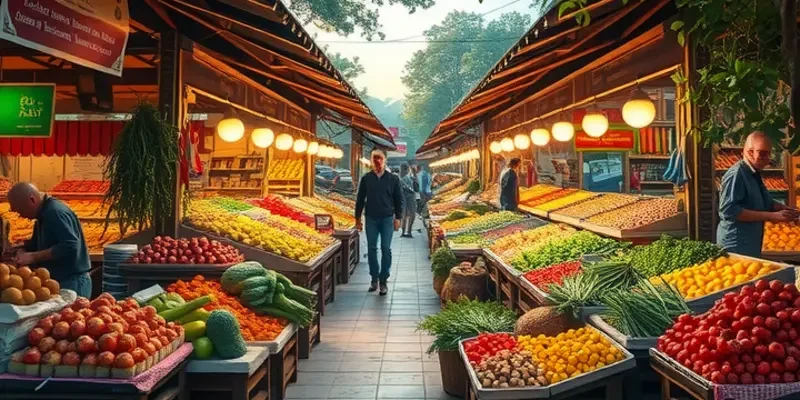Around the globe, snacks serve as delightful connectors to culture and tradition. Each region boasts unique flavors, textures, and preparation methods that reflect its heritage and local ingredients. From the savory to the sweet, these small bites offer a glimpse into the culinary landscape of various communities. Join us as we embark on a flavorful journey to explore snack traditions from distinct corners of the world.
Savoring Street Delights: A Taste of Global Markets

As you wander through the lively lanes of global markets, the vibrant tapestry of street food unfolds before you. Each bite of these roadside delights offers more than mere sustenance; it provides a glimpse into the heart of a culture. Vendors, often with recipes perfected over generations, serve snacks that attract locals and tourists alike. Here, we delve into some of the world’s most celebrated street foods, illustrating their cultural significance and culinary marvel.
In the bustling streets of Istanbul, the scent of freshly baked simit wafts through the air. This circular bread is encrusted in sesame seeds, boasting a crisp crust and soft interior, making it a staple among Turkish snacks. Not far from simit stalls, you might encounter vendors skillfully shaping and frying lahmacun. Often described as Turkish pizza, lahmacun features a thin, crispy base topped with savory minced meat, herbs, and spices.
Across continents, the streets of Mexico come alive with the vibrant energy of taco stands. These iconic snacks, featuring corn tortillas filled with everything from marinated pork to flavorful beans, are an embodiment of Mexico’s culinary diversity. Tacos invite personalization: add freshly chopped cilantro, a squeeze of lime, or a dash of fiery salsa to suit your taste.
The allure of Asia’s street food markets is undeniable, with Thailand’s bustling scenes offering an array of exotic flavors. One can’t miss the aromatic grilled satay skewers, commonly made from marinated chicken or pork. These are often served alongside a luscious peanut sauce that balances sweet and spicy notes. Meanwhile, the wok sears and sizzles, churning out fragrant pad thai, a stir-fried noodle dish that harmoniously blends sweetness, saltiness, and acidity.
In India’s chaotic markets, vendors beckon with piles of crispy samosas, triangles of pastry packed with meticulously spiced potatoes and peas. Chaat, another quintessential Indian snack, presents an explosion of flavors with its mix of tamarind chutney, yogurt, and crunchy chickpea noodles. It’s a reflection of India’s penchant for bold flavors and diverse textures.
Street food culture does not merely provide a gastronomic adventure; it plays a crucial social role. Eating alfresco is a communal experience, breaking barriers and fostering conversation among strangers. In cities across the globe, the streets are living, breathing entities where food is a universal language.
These markets are not just about eating but are spaces of innovation and sustainability. Vendors increasingly adapt to environmental challenges, illustrating how street food can also align with sustainable food traditions. From plant-based options to locally sourced ingredients, street food embodies resilience and resourcefulness.
As you sample these diverse creations, remember that each snack carries with it a legacy. These culinary offerings are markers of identity, history, and tradition, bridging us to the past even as they delight our senses in the present. Whether tucked into a bustling alley or a tranquil market square, each street food vendor shares a piece of their world, one delicious bite at a time.
From Home Kitchens to Global Tables: Homemade Snack Recipes

A culinary journey is incomplete without exploring homemade snacks. These delights often hold the essence of family traditions and carry the nostalgia of shared memories. Across cultures, homemade snacks highlight the unique blend of local ingredients and techniques, providing a glimpse into life’s simpler pleasures. From the bustling kitchens of India to the tranquil lands of Japan, each region offers culinary treasures in the form of well-loved snack recipes.
Take, for example, the Indian samosa. This triangular pastry is filled generously with spiced potatoes, peas, or lentils and deep-fried to golden perfection. The origins of the samosa can be traced back through the Silk Road, showing the historical blend of cultural influences in culinary practices. Preparing samosas involves creating a perfectly rolled dough, deftly folding it to resemble its characteristic shape, and frying it delicately to achieve the right crunch. Each bite offers a burst of aromatic spices, connecting us to stories of Indian markets and festive celebrations.
Across the seas, in Italy, bruschetta stands as a testament to the beauty of simplicity. This snack typically features toasted slices of rustic bread topped with ripe tomatoes, basil, and a drizzle of olive oil. The bruschetta dates back to ancient times when Romans savored their bread with newly pressed olive oil. The minimal preparation allows the freshness of Italian ingredients to shine, transforming a humble dish into a vibrant expression of the Italian dolce vita.
Meanwhile, the humble Japanese onigiri, or rice ball, offers comfort and convenience. Often wrapped in a delicate layer of seaweed, onigiri can be filled with ingredients like salted salmon, pickled plum, or tuna mixed with mayonnaise. This traditional snack is a testament to Japan’s frugality and genius for preserving flavors. Perfecting onigiri requires mastering the art of rice-cooking and forming, but it invites endless personalization, making it a family-friendly treat across generational gaps.
The common thread knitting together these snacks is their role in nurturing familial bonds. Kitchens transform into spaces of storytelling, where parents share their culinary secrets with eager children. Preparing homemade snacks can be an engaging activity, fostering connections and creating long-lasting memories.
As you explore these snacks, consider how they embody cultural identity and family traditions. Each recipe is a window into the lives of people worldwide, offering comfort and joy through cherished flavors. For those inspired to try these at home, these snacks are not only delicious but also a rememberence of collective culinary wisdom.
For those interested in deeper explorations into culinary techniques, the blog on sustainable food traditions offers insights into how ancient methods shape today’s gastronomic scenes. Unraveling these aspects may inspire a renewed appreciation for the snacks you create and enjoy.
Final words
Snacks are far more than quick bites; they represent the essence of cultural traditions, community bonds, and culinary creativity. Through the exploration of global snack traditions, we’ve uncovered stories that engage the senses and foster connections between people. As you venture into your culinary experiences, remember that with every snack, you’re savoring a piece of someone’s heritage. So, whether you’re in your kitchen or a bustling street market, embrace the adventure of tasting the world, one tiny bite at a time.








